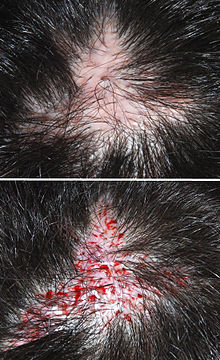Hair transplantation is a surgical technique that involves moving individual hair follicles from one part of the body (the donor site) to bald or balding parts (the recipient site). It is primarily used to treat male pattern baldness, whereby grafts containing hair follicles that are genetically resistant to balding are transplanted to bald scalp. However, it is also used to restore eyelashes, eyebrows, beard hair, chest hair, and pubic hair and to fill in scars caused by accidents or surgery such as face-lifts and previous hair transplants. Hair transplantation differs from skin grafting in that grafts contain almost all of the epidermis and dermis surrounding the hair follicle, and many tiny grafts are transplanted rather than a single strip of skin.
Since hair naturally grows in follicles that contain groupings of 1 to 4 hairs, today’s most advanced techniques transplant these naturally occurring 1–4 hair "follicular units" in their natural groupings. Thus modern hair transplantation can achieve a natural appearance by mimicking nature hair for hair. This hair transplant procedure is called Follicular Unit Transplantation (FUT). Donor hair can be harvested in two very different ways;
1. Strip Harvesting - a strip of scalp is removed under local anesthesia, the wound is then sutured back together and this piece of scalp tissue is then cut in to small pieces of tissue called grafts which are then transplanted back in to the thinning area of the patients head. This method will leave a linear scar in the donor area, which should be covered by a patients hair (if long). The recovery period is around 2 weeks and will require the stitches to be removed by medical personnel.
2. Follicular Unit Extraction or FUE Harvesting - individual follicles of hair are removed under local anesthesia; this micro removal uses tiny punches of between 0.6mm and 1.25mm in diameter. Each follicle is then reinserted back in to the scalp in the thinning area using a micro blade. Because individual follicles are removed, only small, punctate scars remain and any post-surgical pain is minimized. As no suture removal is required, recovery from FUE is within 7 days.
Transplant operations are performed on an outpatient basis, with mild sedation (optional) and injected local anesthesia, which typically last about six hours. The scalp is shampooed and then treated with an antibacterial agent prior to the donor scalp being harvested.
In the usual follicular unit procedure, the surgeon harvests a strip of skin from the posterior scalp, in an area of good hair growth. The excised strip is about 1–1.5 x 15–30 cm in size. While closing the resulting wound, assistants begin to dissect individual follicular unit grafts from the strip. Working with binocular Stereo-microscopes, they carefully remove excess fibrous and fatty tissue while trying to avoid damage to the follicular cells that will be used for grafting. The latest method of closure is called 'Trichophytic closure' which results in much finer scars at the donor area.
FUE harvesting negates the need for large areas of scalp tissue to be harvested and can give very natural results with little or no scarring.
The surgeon then uses very small micro blades or fine needles to puncture the sites for receiving the grafts, placing them in a predetermined density and pattern, and angling the wounds in a consistent fashion to promote a realistic hair pattern. The technicians generally do the final part of the procedure, inserting the individual grafts in place.
Hair thinning, known as "shock loss", is a common side effect that is usually temporary. Bald patches are also common, as fifty to a hundred hairs can be lost each day.
Other side effects include swelling of areas such as the scalp and forehead. If this becomes uncomfortable, medication may ease the swelling. Additionally, the patient must be careful if his scalp starts itching, as scratching will make it worse and cause scabs to form. A moisturizer or massage shampoo may be used in order to relieve the itching.
Several years after the surgery, more hair loss can occur, with the transplanted patches staying in place. This results in odd patches of hair, unless they are removed, or unless more hair is transplanted.

No comments:
Post a Comment